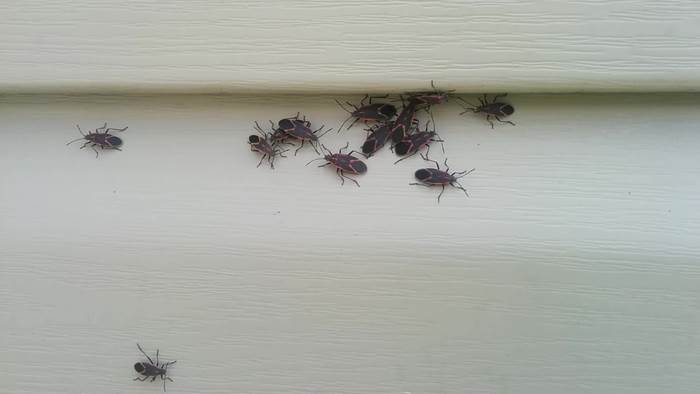If your home is covered in vinyl siding, the last thing you want is for it to become infested with bugs! Here, you’ll learn how to keep all kinds of insects away from your house’s exterior.
If you have a bug problem you’re desperate to deal with, then you’re definitely in the right place. Read on for all the information you need to keep bugs off your vinyl siding.
- How To Keep Bugs Off Vinyl Siding?
- Can Carpenter Bees Eat Through Vinyl Siding?
- Can Termites Eat Through Vinyl Siding?
- What Can I Spray Around My House To Keep Bugs Out?
- How To Keep Spider Webs Off Vinyl Siding?
- How Do You Get Rid Of Spider Webs On Vinyl Siding?
- How Do You Get Rid Of Flies On Vinyl Siding?
- What Is The Best Cleaning Solution For Vinyl Siding?
How To Keep Bugs Off Vinyl Siding:
There are so many advantages to vinyl siding: it’s affordable, it’s insulating, and it’s very low maintenance. However, there are drawbacks too. One is that it can become a breeding ground for bugs.
To keep bugs off your vinyl siding, limit their food.
You can do this by clearing away dead insects from outside your home. You might find them on window seals and under your clapper boards. These naturally attract other bugs!
You can also seal up any gaps and cracks. If your siding has damaged areas, these offer cool, dark spaces for bugs to congregate.
Fill them in with sealant or caulk instead and replace broken boards. Look to your window trim and between your porch boards especially.
The insecticide is helpful for this purpose.
Apply it to your house’s perimeter, especially at the trim of your doors and around your windowsills. These can be shelter areas for bugs.
It can be lovely to light up your house’s exterior, but outdoor lighting can attract bugs. You can make your house less appealing to them by removing any unnecessary lights.
Can Carpenter Bees Eat Through Vinyl Siding?
You may have heard of carpenter bees. They look like bumblebees but they have a shiny black abdomen, unlike their fuzzy counterparts!
Carpenter bees aren’t especially dangerous, but they’re known for being destructive.
They make their nests in softwood, hence their name: carpenter bees! They bore into the wood, making holes and tunnels that can cause serious damage.
The good news is that vinyl siding cannot be penetrated by carpenter bees.
In this way, it’s far superior to wood siding. If you love the look of wood siding but you don’t want to risk attracting carpenter bees, remember there is vinyl siding available that looks like wood.
Your only issue could be if your vinyl siding is damaged, revealing the wood underneath.
Then, you might find that carpenter bees can slide into the infrastructure of your home and cause some major problems.
The best way to prevent this from happening is to ensure that you maintain your vinyl siding, replacing any damaged boards as quickly as possible.
Vinyl siding will generally protect you from carpenter bees.
Can Termites Eat Through Vinyl Siding?
The biggest bug problem a house can face is undoubtedly termites. They pose a serious threat to the integrity of your home.
They’re able to get through all kinds of siding, including vinyl and even metal, and once inside they can feast on your furniture!
For this reason, you should be very aware of any signs that termites have reached your property.
For example, if you see winged swarmers, this is a sign that a termite colony has been established.
You might find wings on window sills, decks, or patios too. Termites build mud tubes to protest themselves as they crawl into your home.
If you see these shelter tubes, it’s a clear indication that you have a termite problem.
Termite damage on the exterior of your home will make it look like it was attacked with a knife. Look at dark, moist spots for signs of termite activity.
If the paint on your walls or floors is buckling, it may be because termites are pushing it up. They’re also known for creating small holes.
What Can I Spray Around My House To Keep Bugs Out?
There are many different products on the market designed to keep bugs out of your home. Here are some you might like to consider:
- Ortho Home Defense MAX
This formula is fast-acting. It not only kills the bugs that are already in your home, but it also prevents other bugs from appearing! It claims to be effective against over 130 types of insects, and it lasts for up to 12 months once you’ve applied it.
- Eco Defense Home Pest Control Spray
What attracts people to the Eco Defense Home Pest Control Spray is that it’s made with all-natural ingredients. This makes it safe to be used around pets and children. There are no harmful fumes or chemicals involved. It can be used indoors and outdoors, too.
- Talstar Pro Multi-Use Insecticide
Talstar Pro Multi-Use Insecticide claims to control over 75 different pests. It’s commonly used by pest control experts. You may need to buy this product in bulk, but it will last you a long time! Once applied, effects continue for up to 3 months. You should keep pets and kids away while this dries.
- Orange Guard Home Pest Control
Orange Guard Home Pest Control uses a water-based formula so it’s safe to use. It can be used indoors and outdoors.
The active ingredient in this product is orange peel extract (d-Limonene) which is often used in pest control.
Other well-known brands like Raid also offer pest control products.
How To Keep Spider Webs Off Vinyl Siding:
There is some maintenance work you can carry out to keep spiderwebs away from your vinyl siding.
One step you can take is to fill in all the crevices and cracks in your window ledges or door frames.
These are ideal spaces for a spider to set up their web!
You can also use natural remedies that repel spiders. For example, you might place eucalyptus sprigs around the perimeter of your house.
You can also make your own spider repellent using table salt and water. Spray it around your house once a week.
Spiders hate peppermint oil too.
The best way to keep spiderwebs from becoming a problem is to remove them at the earliest sign.
Check up on your vinyl siding regularly so you’re quickly alerted to any new developments.
A combination of home maintenance, natural repellants, and quick removal will stop spiderwebs in their tracks!
How Do You Get Rid Of Spider Webs On Vinyl Siding?
To get rid of any spider webs that have accumulated on your vinyl siding, you can use two different methods.
The first is to sweep away the spiders’ homes. You can do this using a broom. Of course, this method is best for low-lying spiderwebs.
What if they’re a little high up for you to sweep away? In that case, you can use a pressure washer.
It’s a good idea to regularly wash your vinyl siding using a pressure washer, as every spider web may not be visible to you.
Don’t have a pressure washer? Try a garden hose!
Once you’ve cleaned them away, you can use spider repellents to make sure they don’t come back.
Natural repellents are very effective, but if you’d rather pick one up from the store, try these:
- Miss Muffet’s Revenge – this can keep spiders away for up to 12 months!
- Star Brite Spider Away Repellant – it’s child and pet-friendly.
- Hot Shot Spider & Scorpion Killer – you can use this indoors and outdoors.
How Do You Get Rid Of Flies On Vinyl Siding?
Over time, organic materials such as sugar particles will accumulate on your vinyl siding. This is a problem because it can attract flies.
To prevent this issue, clean it regularly. You can do this using a regular garden hose.
If your vinyl siding has a flower garden, trees, or other vegetation nearby, it’s a good idea to make this a weekly event.
You can also apply natural fly repellents to make your vinyl siding less attractive.
Little known fact: flies hate the smell of vodka!
If you mix vodka, aloe vera juice, and organic lemon eucalyptus oil, this makes an effective solution for keeping flies at bay. Spray it all over the areas you’ve noticed flies congregating.
What Is The Best Cleaning Solution For Vinyl Siding?
There are many great solutions you can use to clean your vinyl siding.
What’s even better is that you can make them from items you probably have around the house already.
For example, water can be mixed with white vinegar to make vinyl siding cleaner. It’s so effective that it will even remove light mold and mildew stains.
If you need something stronger, try mixing 1/3 cup of powdered laundry detergent, 2/3 cup powdered household cleaner and 1/3 liquid laundry bleach with a gallon of water.
You can use most general household cleansers on any tough dirt or stains, but you should check the ingredients first. You don’t want to stain or warp your vinyl siding!
For an eco-friendly solution that won’t harm your landscaping, mix one cup of oxygen bleach with a gallon of water. This is a gentler cleaner that’s still very effective.
PROFESSIONAL PEST CONTROL SERVICE

OR
FILL OUT THE FORM BELOW TO GET A FREE QUOTE
Vinyl Siding Related Posts
- How To Cut Vinyl Siding (Explained For Beginners)
- How To Hang Things On Vinyl Siding?
- How To Get Stain Off Vinyl Siding (Complete Guide)
- How to Repair Vinyl Siding (Quick Facts)
- Painting Vinyl Siding: 8 Answers You Should Know!
- Vinyl Siding: Effective Insulator or Not? (Everything You Need to Know)
- Vinyl Siding: Is It Right For Your Home? Find Out Here!
- Vinyl Siding: The Complete Maintenance Guide

